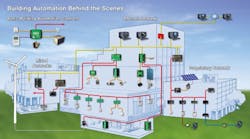Global Building Automation Market Expected to Grow 60% in Next Decade
A report, by Navigant Research, examines commercial building automation systems (BAS) and sees global revenue in the field rising from $58.1 billion in 2013 to $100.8 billion by 2021. The report says that growth in commercial BAS will be driven by new and retrofit commercial building construction, with concerns about global warming and heightened energy efficiency requirements serving as the chief spur for adoption of the technology.
According to the report, the BAS market has suffered from half a decade in the doldrums as a result of the 2008 Global Financial Crisis (GFC), and renewed economic growth in tandem with increased energy efficiency targets should boost its health over the remainder of the decade.
The report further points out that technological advances will fundamentally alter the nature of the products and services on offer within the commercial BAS market, and will encompass areas including new embedded computing, communications, sensing, and software. These changes will present both opportunities and risks for existing market players, who can either capitalize on new developments or find themselves left in the dust by fresh competition.
The commercial market will continue to evolve from point solutions based on proprietary technology and products toward the open and integrated systems facilitated by modern digital information technologies.
This will permit the automation of HVAC, lighting, fire and personal safety, and safety and access control, and their incorporation into new building management systems.
The U.S., whose real estate sector was at the center of the 2008 GFC, is expected by another research report to enjoy flourishing growth in its domestic building automation equipment market over the next five years.
A new report from IHS expects the US market for building automation equipment to grow by over 40% over the next five years to reach $2.24 billion.
The IHS report also concludes that a key motivating factor for the uptake of building automation will be efforts to raise energy efficiency, particularly as the cost of electricity rises and demand for low energy consumption facilities rises.
IHS CERA forecasts an eight percent rise in prices for retail electrical power from 2012 to 2020.










